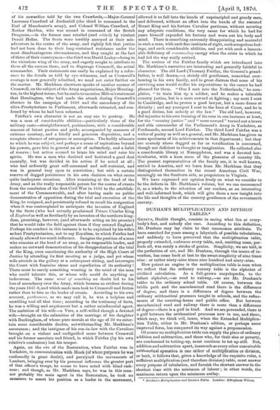DUNHAM'S MULTIPLICATION AND DIVISION TABLES.* GENIUS, Hazlitt thought, consists in
seeing what lies at every- body's feet, and nobody else sees. According to this definition, Mr. Dunham may lay claim to that uncommon attribute. To have searched for years among a labyrinth of possible tabulations, and suddenly to have perceived that the multiplication table, properly extended, embraces every table, and, omitting none, per- fects all, was surely a stroke of genius. Simplicity, we are told, is the perfection of art, and Mr. Dunham, through the mazes of in- vention, has come back at last to the sweet simplicity of nine times nine : or rather flinty-nine times nine hundred and flinty-nine.
How potent an engine is the multiplication table is seen when we reflect that the ordinary nursery table is the alphabet of civilized calculation. As a full-grown encyclopmdia, to the infant alphabet,—as road to railway,—so are Mr. Dunham's tables to the ordinary school table. Of course, between the bridle path and the macadamized road there is the difference of degree, and there is a difference of degree between the ordinary arithmetical processes taught in schools, and the refine- ments of the counting-house and public office. But between macadamized road and railway there is more than a difference of degree—there is a gulf in kind. And we are persuaded, there is a gulf between the arithmetical processes now in use, and those, which may, we think will, inure, when the Extended Multiplica- tion Table, either in Mr. Dunham's edition, or perhaps some improved form, has conquered its way against a prepossession.
Of course no multiplication table can supply the place of ordinary addition and subtraction, and those who, for their sins or poverty, are condemned to totting-up, must continue to tot up still. But, addition and subtraction apart, inasmuch as every other conceivable arithmetical operative is one either of multiplication or division, or both, it follows that, given a knowledge of the requisite rules, a sufficient multiplication (and therefore division) table, must answer every purpose of tabulation, and furnish the shortest answer in the shortest time with the minimum of labour ; in other words, the maximum return upon the minimum outlay.
a Dunham's Multiplication and Diviaion Tablet. London: Effingham Wilson.
This result Mr. Dunham's tables have most unquestionably gone a very long way to establish. The comparative view given in his introduction of the complicated calculations required at the Rail- way Clearing House exhibits most striking results. From the examples kindly furnished by the able manager, Mr. Dawson, it is proved that in some cases there is a saving of 300 and in others of 200 per cent. on the ordinary processes.
It would be impossible in the limits of one of our articles to illustrate all the applications of Mr. Dunham's tables. Suffice it to say, that, assuming of course a knowledge of decimals, they apply at once to every question of interest, per-centage, propor- tionate parts, cost of any number at any price in any country, powers and roots, conversion of metric systems for international purposes, and every combination of these various rules. Writing to the Registrar-General, Professor de Morgan says : —" Mr. Dunham's plan is one of solid merit. It is the simple multiplica- tion table, with a large range of multiplicands and multipliers up to 100. Nobody knows better than yourself the substantial use of such a table in all cases of per-centage, that is, in money, business, statistics, and in everything which requires calculation. Mr. Dunham's idea was, that your judgment might be reinforced by an opinion from myself and others. It is not flattering to our age that a certificate in favour of the multiplication table should be wanted. If the claims of routine could be broken, and a new start taken, no table would have higher claims as an assistance in the
business of life My own very wide experience satisfies me that great service would be done by the dissemination of such a table as Mr. Dunham is engaged upon."
In their present form, the multiplicands run from 1 to 1,000. A loose extension table carries the tables to 10,000. With prac- tice any number of figures whatever can be multiplied by any two figures, and written off in one line. The whole work forms a very thin folio demy, each page containing twenty-five multi- plicands. A projecting label accompanies each page, and any number required is therefore turned to at once without search. It is quite true, that a first-rate clerk put upon his mettle might even on the old methods, straining his energies, keep pace for a time with an inexperienced hand using the tables. But wherever practice was equal on both sides, the quickest clerk would stand no more chance against the tables than an old coach and four against a railway.
But not only is there a vast saving of time, the saving in the mental wear and tear is incalculable. We believe, indeed, we have authority for saying, that whereas the clerks who employ Mr. Dunham's multiplication tables, were often before their use all but "drunk with fatigue" after a long day's calculation, they now leave their work compara- tively fresh and elastic. These tables are, therefore, well worthy of public attention and study, and we believe we have also authority for stating that if any public trial of the relative capa- bilities of the tables could be arranged, several of the clerks at the Railway Clearing House are ready to come forward and compete with any calculators who think the older methods preferable. There would be everything to gain and nothing to lose by such a contest, and we are persuaded the issue would not be doubtful.



































 Previous page
Previous page